Paper Menu >>
Journal Menu >>
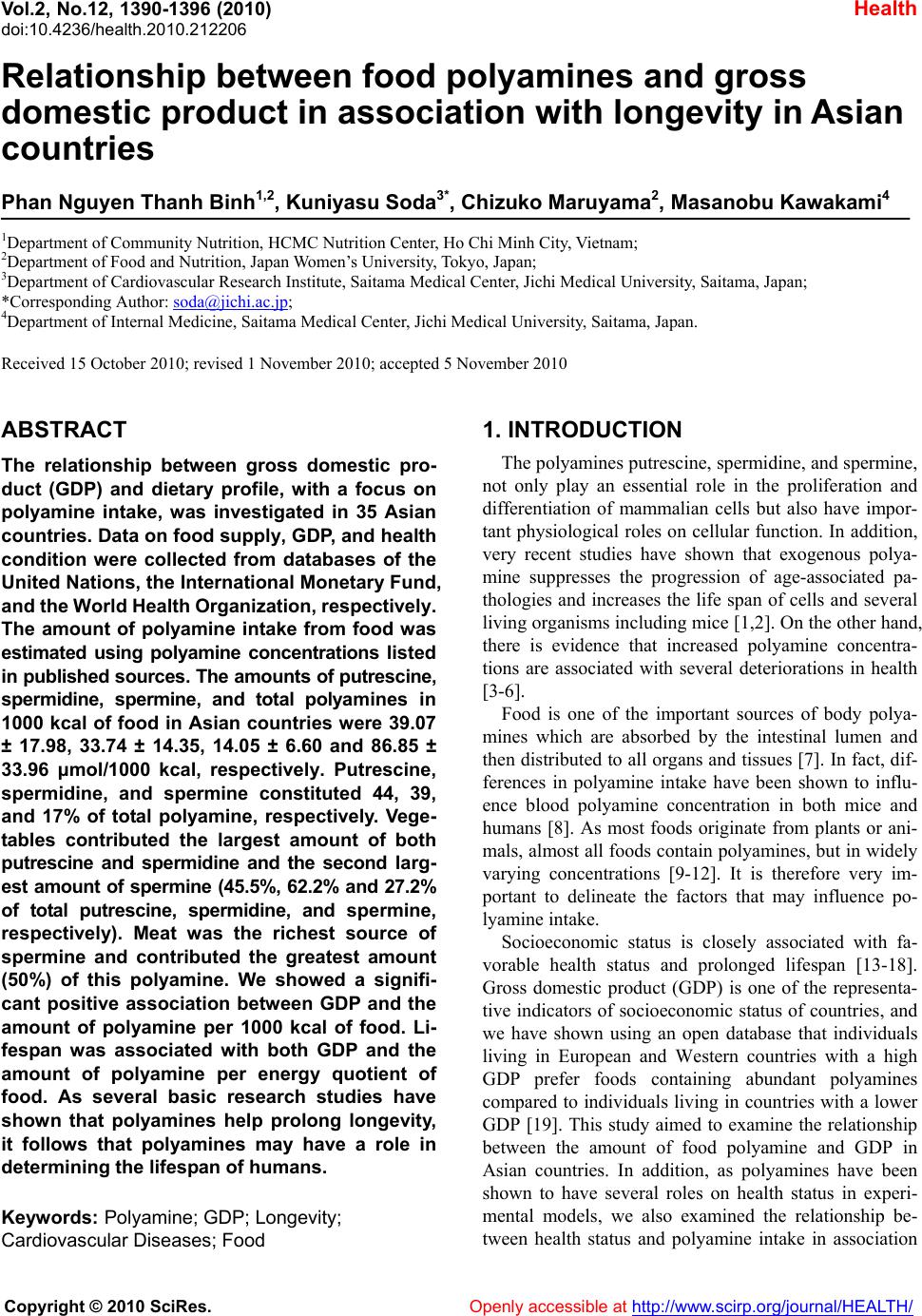 Vol.2, No.12, 1390-1396 (2010) Health doi:10.4236/health.2010.212206 Copyright © 2010 SciRes. Openly accessible at http://www.scirp.org/journal/HEALTH/ Relationship between food polyamines and gross domestic product in association with longevity in Asian countries Phan Nguyen Thanh Binh1,2, Kuniyasu Soda3*, Chizuko Maruyama2, Masanobu Kawakami4 1Department of Community Nutrition, HCMC Nutrition Center, Ho Chi Minh City, Vietnam; 2Department of Food and Nutrition, Japan Women’s University, Tokyo, Japan; 3Department of Cardiovascular Research Institute, Saitama Medical Center, Jichi Medical University, Saitama, Japan; *Corresponding Author: soda@jichi.ac.jp; 4Department of Internal Medicine, Saitama Medical Center, Jichi Medical University, Saitama, Japan. Received 15 October 2010; revised 1 November 2010; accepted 5 November 2010 ABSTRACT The relationship between gross domestic pro- duct (GDP) and dietary profile, with a focus on polyamine intake, was investigated in 35 Asian countries. Data on food supply, GDP, and health condition were collected from databases of the United Nations, the International Monetary Fund, and the World Health Organization, respectively. The amount of polyamine intake from food was estimated using polyamine concentrations listed in published sources. The amounts of putrescine, spermidine, spermine, and total polyamines in 1000 kcal of food in Asian countries were 39.07 ± 17.98, 33.74 ± 14.35, 14.05 ± 6.60 and 86.85 ± 33.96 μmol/1000 kcal, respectively. Putrescine, spermidine, and spermine constituted 44, 39, and 17% of total polyamine, respectively. Vege- tables contributed the largest amount of both putrescine and spermidine and the second larg- est amount of spermine (45.5%, 62.2% and 27.2% of total putrescine, spermidine, and spermine, respectively). Meat was the richest source of spermine and contributed the greatest amount (50%) of this polyamine. We showed a signifi- cant positive association between GDP and the amount of polyamine per 1000 kcal of food. Li- fespan was associated with both GDP and the amount of polyamine per energy quotient of food. As several basic research studies have shown that polyamines help prolong longevity, it follows that polyamines may have a role in determining the lifespan of humans. Keywords: Polyamine; GDP; Longevity; Cardiovascular Diseases; Food 1. INTRODUCTION The polyamines putrescine, spermidine, and spermine, not only play an essential role in the proliferation and differentiation of mammalian cells but also have impor- tant physiological roles on cellular function. In addition, very recent studies have shown that exogenous polya- mine suppresses the progression of age-associated pa- thologies and increases the life span of cells and several living organisms including mice [1,2]. On the other hand, there is evidence that increased polyamine concentra- tions are associated with several deteriorations in health [3-6]. Food is one of the important sources of body polya- mines which are absorbed by the intestinal lumen and then distributed to all organs and tissues [7]. In fact, dif- ferences in polyamine intake have been shown to influ- ence blood polyamine concentration in both mice and humans [8]. As most foods originate from plants or ani- mals, almost all foods contain polyamines, but in widely varying concentrations [9-12]. It is therefore very im- portant to delineate the factors that may influence po- lyamine intake. Socioeconomic status is closely associated with fa- vorable health status and prolonged lifespan [13-18]. Gross domestic product (GDP) is one of the representa- tive indicators of socioeconomic status of countries, and we have shown using an open database that individuals living in European and Western countries with a high GDP prefer foods containing abundant polyamines compared to individuals living in countries with a lower GDP [19]. This study aimed to examine the relationship between the amount of food polyamine and GDP in Asian countries. In addition, as polyamines have been shown to have several roles on health status in experi- mental models, we also examined the relationship be- tween health status and polyamine intake in association  P. N. T. Binh et al. / Health 2 (2010) 1390-1396 Copyright © 2010 SciRes. Openly accessible at http://www.scirp.org/journal/HEALTH/ 1391 with GDP. 2. METHODS AND MATERIALS 2.1. Database Data on food supply in 2002 were obtained from the online database of the Statistics Division of the Food and Agriculture Organization of the United Nations (FAOS- TAT). The target populations were 35 Asian countries that included Bangladesh, Brunei Darussalam, Cambo- dia, China, Democratic People’s Republic of Korea, Fiji, India, Indonesia, Islamic Republic of Iran, Japan, Jordan, Kiribati, Kuwait, Kyrgyzstan, Lao People’s Democratic Republic, Lebanon, Malaysia, Maldives, Mongolia, Myanmar, Nepal, Pakistan, Philippines, Republic of Korea, Samoa, Saudi Arabia, Solomon Islands, Sri Lanka, Syrian Arab Republic, Thailand, Timor-Leste, United Arab Emirates, Vanuatu, Viet Nam, and Yemen. The concentrations of spermine, spermidine, and putrescine in foods were ob- tained from published reports of concentrations meas- ured in Japanese foods [9,10]. When these reports did not show the polyamine content of certain foods, we used additional data obtained from European studies [11,12] (Table 1). All the food items were categorized Table 1. Polyamine contents in Asian foods (nmol/g or nmol/mL)† Food items Putrescine Spermidine Spermine Cereals Barley 17 16 20 Maize 576 144 8 Millet 19 63 48 Oats 41 133 148 Rice (milled equivalent) 8 7.5 1.5 Rye 41 133 148 Sorghum 14 12 0 Wheat 19 29.5 0.5 Other cereals 31.7 90 23.7 Vegetables Cassava 0 0 0 Cloves 0 0 0 Onions 29.5 86.5 4.5 Potatoes 89 68 15.5 Pulses1 26 144 74 Roots & tuber dry equiv2 118 109.3 19.8 Sweet pota- toes 29 25.2 16.5 Tomatoes 146.3 22.5 2.5 Vegetables3 113.5 170.2 17.4 Yams 73 89.5 2 Aquatic plants118 109.3 19.8 Fruits Apples 10 14 0.5 Bananas 160 50 1.5 Grapefruit 436 19.5 1.5 Grapes 106 87 0 Lemons, limes390.5 19 4.5 Oranges, mandarins 432 15.5 0 Pineapples 46 30 0 Citrus, other4 460.2 26.5 0 Fruits, other5 74.5 55.4 4 Beans and Nuts Beans6 147 644.8 299.7 Groundnuts7 18 110 88 Peas8 367 341 32 Sesame seed 29 126 22 Soybean 297 909 235.5 Sunflower seed 34 383 89 Tree nuts9 104.5 108.9 111.6 Seafoods Cephalopods10 3.3 9.3 93.3 Crustaceans11 26.5 0 0 Fish12 27.2 37.1 53.1 Fish, oil 0 0 0 Molluscs13 19.7 143.5 383.5 Aquatic ani- mals and others14 26.3 55.1 87.2 Meat Bovine meat 18.5 17.5 149 Mutton & goat meat 8.2 39.7 131.3 Pig meat 4.5 9.5 165 Poultry meat15 13.3 48.5 3.5 Meat, other 11.5 26.7 194.2 Offal, edible16 63.8 188 825.8 Dairy prod- ucts Butter, ghee, whey & milk 0 0 0 Cheese 0 15 3.5 Cream 0.3 0 0 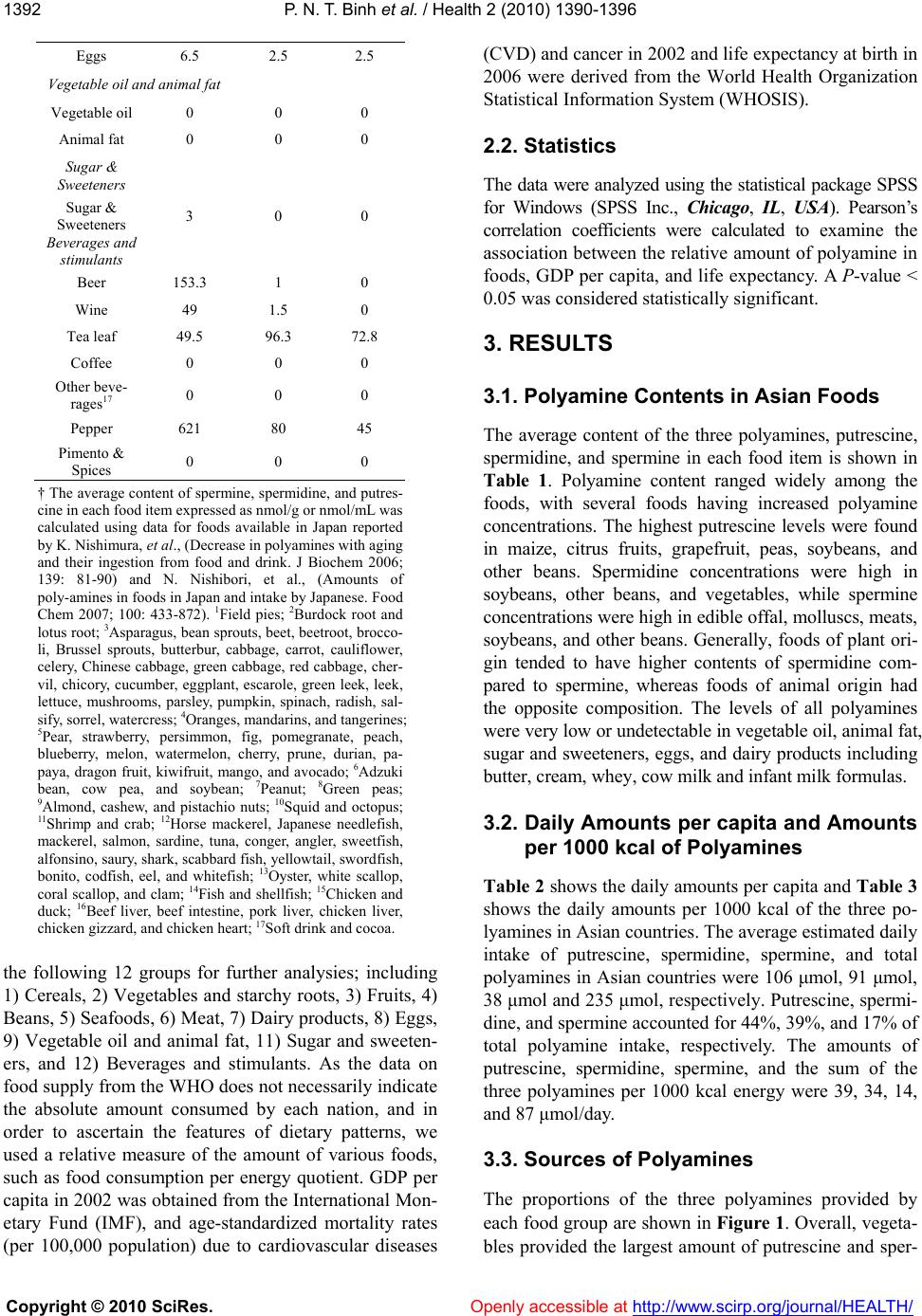 P. N. T. Binh et al. / Health 2 (2010) 1390-1396 Copyright © 2010 SciRes. Openly accessible at http://www.scirp.org/journal/HEALTH/ 1392 Eggs 6.5 2.5 2.5 Vegetable oil and animal fat Vegetable oil 0 0 0 Animal fat 0 0 0 Sugar & Sweeteners Sugar & Sweeteners 3 0 0 Beverages and stimulants Beer 153.3 1 0 Wine 49 1.5 0 Tea leaf 49.5 96.3 72.8 Coffee 0 0 0 Other beve- rages17 0 0 0 Pepper 621 80 45 Pimento & Spices 0 0 0 † The average content of spermine, spermidine, and putres- cine in each food item expressed as nmol/g or nmol/mL was calculated using data for foods available in Japan reported by K. Nishimura, et al., (Decrease in polyamines with aging and their ingestion from food and drink. J Biochem 2006; 139: 81-90) and N. Nishibori, et al., (Amounts of poly-amines in foods in Japan and intake by Japanese. Food Chem 2007; 100: 433-872). 1Field pies; 2Burdock root and lotus root; 3Asparagus, bean sprouts, beet, beetroot, brocco- li, Brussel sprouts, butterbur, cabbage, carrot, cauliflower, celery, Chinese cabbage, green cabbage, red cabbage, cher- vil, chicory, cucumber, eggplant, escarole, green leek, leek, lettuce, mushrooms, parsley, pumpkin, spinach, radish, sal- sify, sorrel, watercress; 4Oranges, mandarins, and tangerines; 5Pear, strawberry, persimmon, fig, pomegranate, peach, blueberry, melon, watermelon, cherry, prune, durian, pa- paya, dragon fruit, kiwifruit, mango, and avocado; 6Adzuki bean, cow pea, and soybean; 7Peanut; 8Green peas; 9Almond, cashew, and pistachio nuts; 10Squid and octopus; 11Shrimp and crab; 12Horse mackerel, Japanese needlefish, mackerel, salmon, sardine, tuna, conger, angler, sweetfish, alfonsino, saury, shark, scabbard fish, yellowtail, swordfish, bonito, codfish, eel, and whitefish; 13Oyster, white scallop, coral scallop, and clam; 14Fish and shellfish; 15Chicken and duck; 16Beef liver, beef intestine, pork liver, chicken liver, chicken gizzard, and chicken heart; 17Soft drink and cocoa. the following 12 groups for further analysies; including 1) Cereals, 2) Vegetables and starchy roots, 3) Fruits, 4) Beans, 5) Seafoods, 6) Meat, 7) Dairy products, 8) Eggs, 9) Vegetable oil and animal fat, 11) Sugar and sweeten- ers, and 12) Beverages and stimulants. As the data on food supply from the WHO does not necessarily indicate the absolute amount consumed by each nation, and in order to ascertain the features of dietary patterns, we used a relative measure of the amount of various foods, such as food consumption per energy quotient. GDP per capita in 2002 was obtained from the International Mon- etary Fund (IMF), and age-standardized mortality rates (per 100,000 population) due to cardiovascular diseases (CVD) and cancer in 2002 and life expectancy at birth in 2006 were derived from the World Health Organization Statistical Information System (WHOSIS). 2.2. Statistics The data were analyzed using the statistical package SPSS for Windows (SPSS Inc., Chicago, IL, USA). Pearson’s correlation coefficients were calculated to examine the association between the relative amount of polyamine in foods, GDP per capita, and life expectancy. A P-value < 0.05 was considered statistically significant. 3. RESULTS 3.1. Polyamine Contents in Asian Foods The average content of the three polyamines, putrescine, spermidine, and spermine in each food item is shown in Table 1. Polyamine content ranged widely among the foods, with several foods having increased polyamine concentrations. The highest putrescine levels were found in maize, citrus fruits, grapefruit, peas, soybeans, and other beans. Spermidine concentrations were high in soybeans, other beans, and vegetables, while spermine concentrations were high in edible offal, molluscs, meats, soybeans, and other beans. Generally, foods of plant ori- gin tended to have higher contents of spermidine com- pared to spermine, whereas foods of animal origin had the opposite composition. The levels of all polyamines were very low or undetectable in vegetable oil, animal fat, sugar and sweeteners, eggs, and dairy products including butter, cream, whey, cow milk and infant milk formulas. 3.2. Daily Amounts per capita and Amounts per 1000 kcal of Polyamines Table 2 shows the daily amounts per capita and Table 3 shows the daily amounts per 1000 kcal of the three po- lyamines in Asian countries. The average estimated daily intake of putrescine, spermidine, spermine, and total polyamines in Asian countries were 106 μmol, 91 μmol, 38 μmol and 235 μmol, respectively. Putrescine, spermi- dine, and spermine accounted for 44%, 39%, and 17% of total polyamine intake, respectively. The amounts of putrescine, spermidine, spermine, and the sum of the three polyamines per 1000 kcal energy were 39, 34, 14, and 87 μmol/day. 3.3. Sources of Polyamines The proportions of the three polyamines provided by each food group are shown in Figure 1. Overall, vegeta- bles provided the largest amount of putrescine and sper- 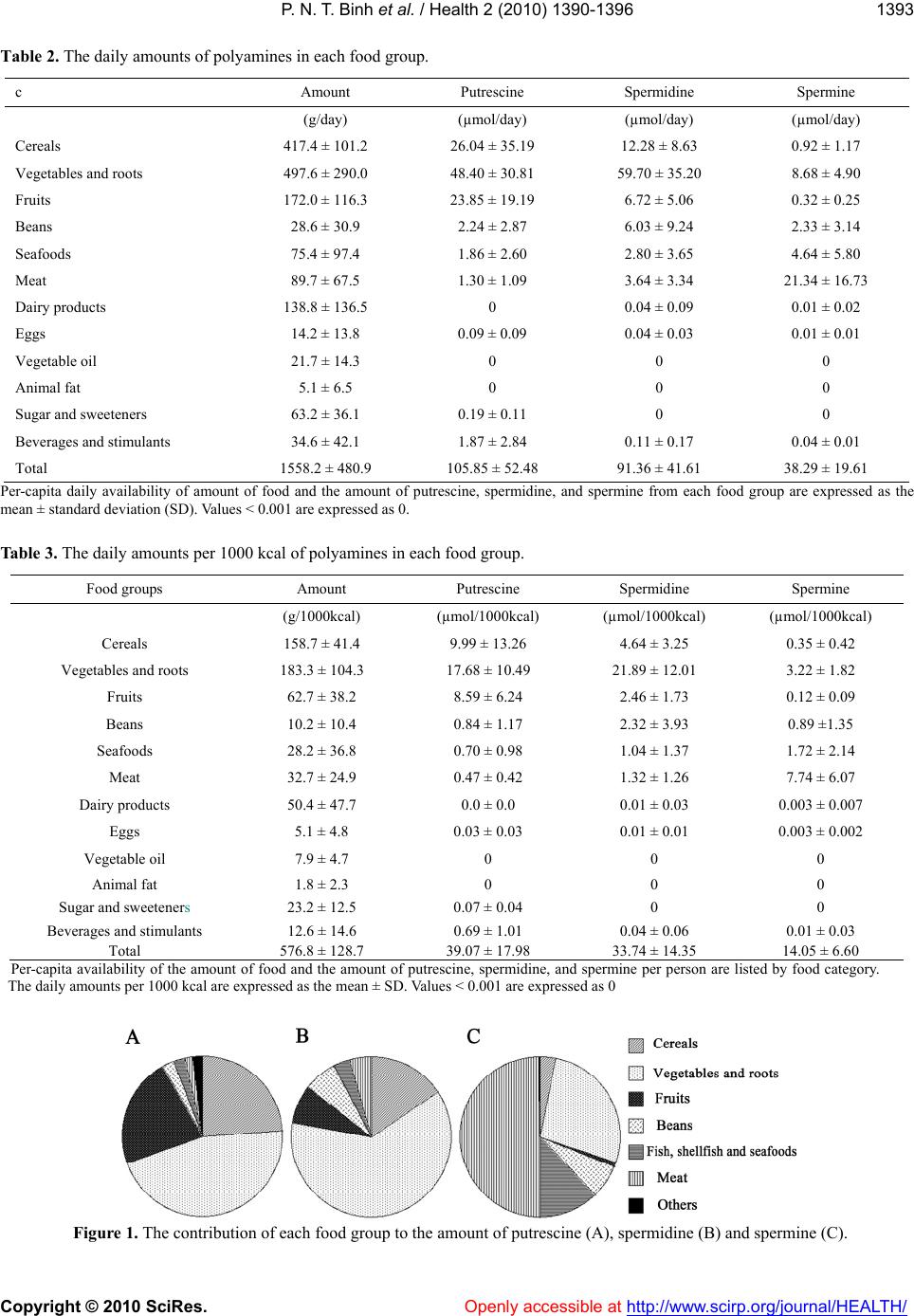 P. N. T. Binh et al. / Health 2 (2010) 1390-1396 Copyright © 2010 SciRes. Openly accessible at http://www.scirp.org/journal/HEALTH/ 1393 Table 2. The daily amounts of polyamines in each food group. c Amount Putrescine Spermidine Spermine (g/day) (µmol/day) (µmol/day) (µmol/day) Cereals 417.4 ± 101.2 26.04 ± 35.19 12.28 ± 8.63 0.92 ± 1.17 Vegetables and roots 497.6 ± 290.0 48.40 ± 30.81 59.70 ± 35.20 8.68 ± 4.90 Fruits 172.0 ± 116.3 23.85 ± 19.19 6.72 ± 5.06 0.32 ± 0.25 Beans 28.6 ± 30.9 2.24 ± 2.87 6.03 ± 9.24 2.33 ± 3.14 Seafoods 75.4 ± 97.4 1.86 ± 2.60 2.80 ± 3.65 4.64 ± 5.80 Meat 89.7 ± 67.5 1.30 ± 1.09 3.64 ± 3.34 21.34 ± 16.73 Dairy products 138.8 ± 136.5 0 0.04 ± 0.09 0.01 ± 0.02 Eggs 14.2 ± 13.8 0.09 ± 0.09 0.04 ± 0.03 0.01 ± 0.01 Vegetable oil 21.7 ± 14.3 0 0 0 Animal fat 5.1 ± 6.5 0 0 0 Sugar and sweeteners 63.2 ± 36.1 0.19 ± 0.11 0 0 Beverages and stimulants 34.6 ± 42.1 1.87 ± 2.84 0.11 ± 0.17 0.04 ± 0.01 Total 1558.2 ± 480.9 105.85 ± 52.48 91.36 ± 41.61 38.29 ± 19.61 Per-capita daily availability of amount of food and the amount of putrescine, spermidine, and spermine from each food group are expressed as the mean ± standard deviation (SD). Values < 0.001 are expressed as 0. Table 3. The daily amounts per 1000 kcal of polyamines in each food group. Food groups Amount Putrescine Spermidine Spermine (g/1000kcal) (µmol/1000kcal) (µmol/1000kcal) (µmol/1000kcal) Cereals 158.7 ± 41.4 9.99 ± 13.26 4.64 ± 3.25 0.35 ± 0.42 Vegetables and roots 183.3 ± 104.3 17.68 ± 10.49 21.89 ± 12.01 3.22 ± 1.82 Fruits 62.7 ± 38.2 8.59 ± 6.24 2.46 ± 1.73 0.12 ± 0.09 Beans 10.2 ± 10.4 0.84 ± 1.17 2.32 ± 3.93 0.89 ±1.35 Seafoods 28.2 ± 36.8 0.70 ± 0.98 1.04 ± 1.37 1.72 ± 2.14 Meat 32.7 ± 24.9 0.47 ± 0.42 1.32 ± 1.26 7.74 ± 6.07 Dairy products 50.4 ± 47.7 0.0 ± 0.0 0.01 ± 0.03 0.003 ± 0.007 Eggs 5.1 ± 4.8 0.03 ± 0.03 0.01 ± 0.01 0.003 ± 0.002 Vegetable oil 7.9 ± 4.7 0 0 0 Animal fat 1.8 ± 2.3 0 0 0 Sugar and sweeteners 23.2 ± 12.5 0.07 ± 0.04 0 0 Beverages and stimulants 12.6 ± 14.6 0.69 ± 1.01 0.04 ± 0.06 0.01 ± 0.03 Total 576.8 ± 128.7 39.07 ± 17.98 33.74 ± 14.35 14.05 ± 6.60 Per-capita availability of the amount of food and the amount of putrescine, spermidine, and spermine per person are listed by food category. The daily amounts per 1000 kcal are expressed as the mean ± SD. Values < 0.001 are expressed as 0 Figure 1. The contribution of each food group to the amount of putrescine (A), spermidine (B) and spermine (C). 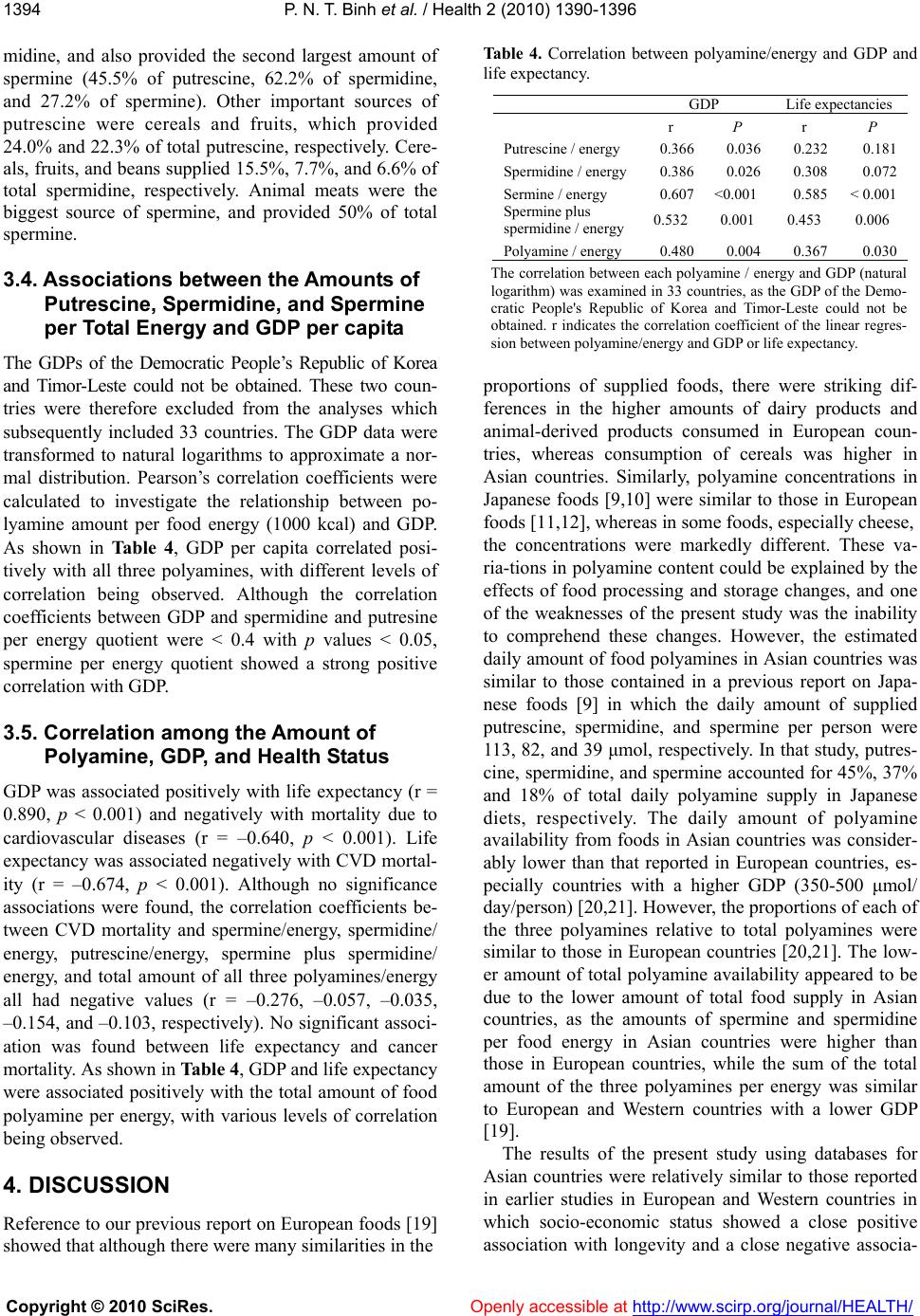 P. N. T. Binh et al. / Health 2 (2010) 1390-1396 Copyright © 2010 SciRes. Openly accessible at http://www.scirp.org/journal/HEALTH/ 1394 midine, and also provided the second largest amount of spermine (45.5% of putrescine, 62.2% of spermidine, and 27.2% of spermine). Other important sources of putrescine were cereals and fruits, which provided 24.0% and 22.3% of total putrescine, respectively. Cere- als, fruits, and beans supplied 15.5%, 7.7%, and 6.6% of total spermidine, respectively. Animal meats were the biggest source of spermine, and provided 50% of total spermine. 3.4. Associations between the Amounts of Putrescine, Spermidine, and Spermine per Total Energy and GDP per capita The GDPs of the Democratic People’s Republic of Korea and Timor-Leste could not be obtained. These two coun- tries were therefore excluded from the analyses which subsequently included 33 countries. The GDP data were transformed to natural logarithms to approximate a nor- mal distribution. Pearson’s correlation coefficients were calculated to investigate the relationship between po- lyamine amount per food energy (1000 kcal) and GDP. As shown in Table 4, GDP per capita correlated posi- tively with all three polyamines, with different levels of correlation being observed. Although the correlation coefficients between GDP and spermidine and putresine per energy quotient were < 0.4 with p values < 0.05, spermine per energy quotient showed a strong positive correlation with GDP. 3.5. Correlation among the Amount of Polyamine, GDP, and Health Status GDP was associated positively with life expectancy (r = 0.890, p < 0.001) and negatively with mortality due to cardiovascular diseases (r = –0.640, p < 0.001). Life expectancy was associated negatively with CVD mortal- ity (r = –0.674, p < 0.001). Although no significance associations were found, the correlation coefficients be- tween CVD mortality and spermine/energy, spermidine/ energy, putrescine/energy, spermine plus spermidine/ energy, and total amount of all three polyamines/energy all had negative values (r = –0.276, –0.057, –0.035, –0.154, and –0.103, respectively). No significant associ- ation was found between life expectancy and cancer mortality. As shown in Table 4, GDP and life expectancy were associated positively with the total amount of food polyamine per energy, with various levels of correlation being observed. 4. DISCUSSION Reference to our previous report on European foods [19] showed that although there were many similarities in the Table 4. Correlation between polyamine/energy and GDP and life expectancy. GDP Life expectancies r P r P Putrescine / energy 0.366 0.036 0.232 0.181 Spermidine / energy0.386 0.026 0.308 0.072 Sermine / energy 0.607 <0.001 0.585 < 0.001 Spermine plus spermidine / energy0.532 0.001 0.453 0.006 Polyamine / energy 0.480 0.004 0.367 0.030 The correlation between each polyamine / energy and GDP (natural logarithm) was examined in 33 countries, as the GDP of the Demo- cratic People's Republic of Korea and Timor-Leste could not be obtained. r indicates the correlation coefficient of the linear regres- sion between polyamine/energy and GDP or life expectancy. proportions of supplied foods, there were striking dif- ferences in the higher amounts of dairy products and animal-derived products consumed in European coun- tries, whereas consumption of cereals was higher in Asian countries. Similarly, polyamine concentrations in Japanese foods [9,10] were similar to those in European foods [11,12], whereas in some foods, especially cheese, the concentrations were markedly different. These va- ria-tions in polyamine content could be explained by the effects of food processing and storage changes, and one of the weaknesses of the present study was the inability to comprehend these changes. However, the estimated daily amount of food polyamines in Asian countries was similar to those contained in a previous report on Japa- nese foods [9] in which the daily amount of supplied putrescine, spermidine, and spermine per person were 113, 82, and 39 μmol, respectively. In that study, putres- cine, spermidine, and spermine accounted for 45%, 37% and 18% of total daily polyamine supply in Japanese diets, respectively. The daily amount of polyamine availability from foods in Asian countries was consider- ably lower than that reported in European countries, es- pecially countries with a higher GDP (350-500 μmol/ day/person) [20,21]. However, the proportions of each of the three polyamines relative to total polyamines were similar to those in European countries [20,21]. The low- er amount of total polyamine availability appeared to be due to the lower amount of total food supply in Asian countries, as the amounts of spermine and spermidine per food energy in Asian countries were higher than those in European countries, while the sum of the total amount of the three polyamines per energy was similar to European and Western countries with a lower GDP [19]. The results of the present study using databases for Asian countries were relatively similar to those reported in earlier studies in European and Western countries in which socio-economic status showed a close positive association with longevity and a close negative associa-  P. N. T. Binh et al. / Health 2 (2010) 1390-1396 Copyright © 2010 SciRes. Openly accessible at http://www.scirp.org/journal/HEALTH/ 1395 tion with CVD mortality [13-18]. The results of the present study also indicated that reducing the incidence of CVD is very important for improving health status and prolonging lifespan, even in Asian countries. Studies using personal databases have shown decreases in CVD incidence and increases in life span are often associated with socioeconomic status [13-18]. Although the factors affecting health condition according to socioeconomic status are not fully understood, the present study showed that the amount of polyamine in foods was associated closely with GDP per capita. A very interesting finding in our study was that the amount of food polyamine per energy quotient was associated not only positively with GDP but also negatively with CVD incidence. As the current study was an ecological investigation, it would therefore be expected there were potential confounding factors in these associations. However, recent basic re- search studies have shown that increased polyamine in- take prolongs the longevity of some small organisms and rodents [1,2], and therefore increased polyamine intake may theoretically help maintain vascular health by in- creasing the amount of arginine available for nitric oxide (NO) synthesis [22-25]. These findings and those of the present study suggest a possible role of food polyamines on human health. REFERENCES [1] Eisenberg, T., Knauer, H., Schauer, A., Buttner, S., Ruckenstuhl, C., Carmona-Gutierrez, D., Ring, J., Schroeder, S., Magnes, C., Antonacci, L., Fussi, H., Deszcz, L., Hartl, R., Schraml, E., Criollo, A., Megalou, E., Weiskopf, D., Laun, P., Heeren, G., Breitenbach, M., Grubeck-Loebenstein, B., Herker, E., Fahrenkrog, B., Frohlich, K.U., Sinner, F., Tavernarakis, N., Minois, N., Kroemer, G. and Madeo, F. (2009) Induction of autopha- gy by spermidine promotes longevity. Nature Cell Biol- ogy, 11 , 1305-1314. [2] Soda, K., Dobashi, Y., Kano, Y., Tsujinaka, S. and Koni- shi, F. (2009) Polyamine-rich food decreases age-associated pathology and mortality in aged mice. Experimental Gerontology, 44, 727-732. [3] Quemener, V., Chamaillard, L., Brachet, P., Havouis, R. and Moulinoux, J.P. (1994) Involvement of polyamines in malignant proliferative processes: Antineoplastic ef- fects of a polyamine deficiency. Bulletin de l'Academie Nationale de Medecine, 178, 1591-1605. [4] Quemener, V., Blanchard, Y., Chamaillard, L., Havouis, R., Cipolla, B. and Moulinoux, J.P. (1994) Polyamine deprivation: A new tool in cancer treatment. Anticancer Research, 14, 443-448. [5] Pegg, A.E. (1988) Polyamine metabolism and its impor- tance in neoplastic growth and a target for chemotherapy. Cancer Research, 48, 759-774. [6] Marton, L.J. and Pegg, A.E. (1995) Polyamines as targets for therapeutic intervention. Annual Review of Pharma- cology and Toxicology, 35, 55-91. [7] Bardocz, S., White, A., Grant, G., Brown, D.S., Duguid, T.G. and Pusztai, A. (1996) Uptake and bioavailability of dietary polyamines. Biochemical Society Transactions, 24, 226S. [8] Soda, K., Kano, Y., Sakuragi, M., Takao, K., Lefor, A. and Konishi, F. (2009) Long-term oral polyamine intake increases blood polyamine concentrations. Journal Nu- trition Science and Vitaminology (Tokyo), 55, 361-366. [9] Nishibori, N., Fujihara, S. and Akatuki, T. (2007) Amounts of polyamines in foods in Japan and intake by Japanese. Food Chemistry, 100, 491-497. [10] Nishimura, K., Shiina, R., Kashiwagi, K. and Igarashi, K. (2006) Decrease in polyamines with aging and their in- gestion from food and drink. Journal of Biochemistry, 139, 81-90. [11] Cipolla, B.G., Havouis, R. and Moulinoux, J.P. (2007) Polyamine contents in current foods: A basis for polya- mine reduced diet and a study of its long term obser- vance and tolerance in prostate carcinoma patients. Ami- no Acids, 33, 203-212. [12] Bardócz, S., Grant, G., Brown, D.S., Ralph, A. and Pusz- tai, A. (1993) Polyamines in food—implications for growth and health. Journal of Nutrition Biochemistry, 4, 66-71. [13] Cooper, R., Cutler, J., Desvigne-Nickens, P., Fortmann, S. P., Friedman, L., Havlik, R., Hogelin, G., Marler, J., McGovern, P., Morosco, G., Mosca, L., Pearson, T., Stamler, J., Stryer, D. and Thom, T. (2000) Trends and disparities in coronary heart disease, stroke, and other cardiovascular diseases in the United States: Findings of the national conference on cardiovascular disease pre- vention. Circulation, 102, 3137-3147. [14] Kaplan, G.A. and Keil, J.E. (1993) Socioeconomic fac- tors and cardiovascular disease: a review of the literature. Circulation, 88, 1973-1998. [15] Rooks, R.N., Simonsick, E.M., Miles, T., Newman, A., Kritchevsky, S.B., Schulz, R. and Harris, T. (2002) The association of race and socioeconomic status with cardi- ovascular disease indicators among older adults in the health, aging, and body composition study. Journals of Gerontology, 57, S247-256. [16] Janssen, F., Kunst, A.E. and Mackenbach, J.P. (2006) Association between gross domestic product throughout the life course and old-age mortality across birth cohorts: parallel analyses of seven European countries, 1950-1999. Social Science & Medicine, 63, 239-254. [17] Tresserras, R., Canela, J., Alvarez, J., Sentis, J. and Sal- leras, L. (1992) Infant mortality, per capita income, and adult illiteracy: an ecological approach. American Jour- nal of Public Health, 82, 435-438. [18] Beckfield, J. (2004) Does income inequality harm health? New cross-national evidence. Journal of Health & Social Behavior, 45, 231-248. [19] Binh, P.N.T., Soda, K. and Kawakami, M. (2010) Gross domestic product and dietary pattern among 49 Western countries with a focus on polyamine intake. Health, 2, in press. [20] Bardocz, S., Duguid, T.J., Brown, D.S., Grant, G., Pusztai, A., White, A. and Ralph, A. (1995) The importance of dietary polyamines in cell regeneration and growth. Brit- ish Journal of Nutrition, 73, 819-828. [21] Zoumas-Morse, C., Rock, C.L., Quintana, E.L., Neuh- 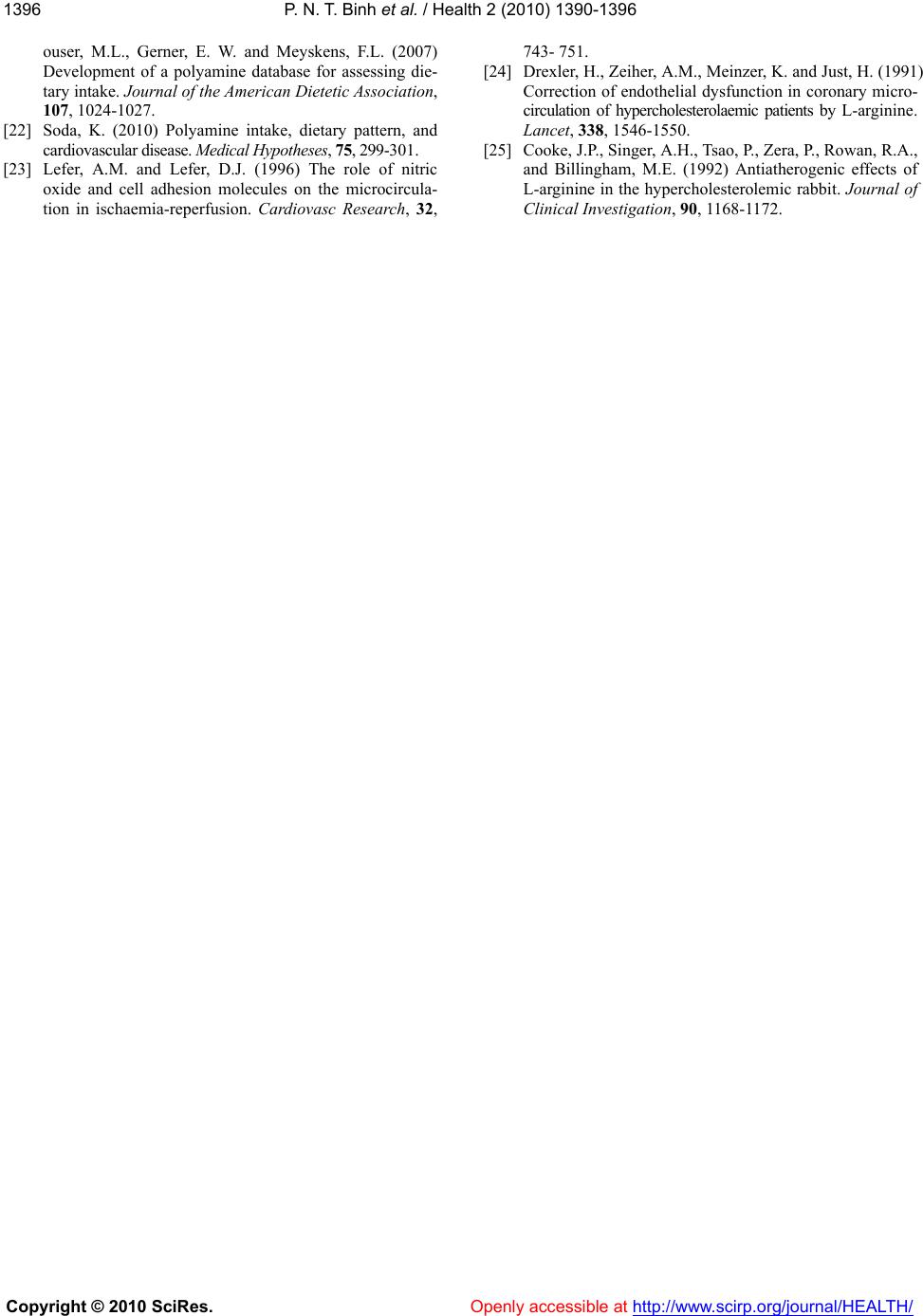 P. N. T. Binh et al. / Health 2 (2010) 1390-1396 Copyright © 2010 SciRes. Openly accessible at http://www.scirp.org/journal/HEALTH/ 1396 ouser, M.L., Gerner, E. W. and Meyskens, F.L. (2007) Development of a polyamine database for assessing die- tary intake. Journal of the American Dietetic Association, 107, 1024-1027. [22] Soda, K. (2010) Polyamine intake, dietary pattern, and cardiovascular disease. Medica l H ypoth es es, 75, 299-301. [23] Lefer, A.M. and Lefer, D.J. (1996) The role of nitric oxide and cell adhesion molecules on the microcircula- tion in ischaemia-reperfusion. Cardiovasc Research, 32, 743- 751. [24] Drexler, H., Zeiher, A.M., Meinzer, K. and Just, H. (1991) Correction of endothelial dysfunction in coronary micro- circulation of hypercholesterolaemic patients by L-arginine. Lancet, 338, 1546-1550. [25] Cooke, J.P., Singer, A.H., Tsao, P., Zera, P., Rowan, R.A., and Billingham, M.E. (1992) Antiatherogenic effects of L-arginine in the hypercholesterolemic rabbit. Journal of Clinical Investigation, 90, 1168-1172. |

